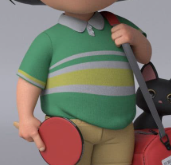I am having a hard time understanding the interaction between slots and materials. For example, what is the real utility of slots? It seems to me that, for example, if you had 3 different mesh objects and assigned a different slot (one color per slot) to each object; it would be just as easy to assign all 3 objects to the same slot and have all 3 colors in that single slot. I beieve the same logic would hold true if you have 1 mesh object and 3 different sections assigned different colors on that object. I hope this example makes sense. What am I missing?
The interaction is a slot connects a material to an object. For example if I have 6 materials(red, purple, green, pink, yellow, and blue) and the default cube with no slots. Then the cube has no material. If I add a slot I can now connect a material to that slot and the material will apply to the whole cube. The color of the cube will be determined by the material assigned to the slot. I can add another slot(2) and assign it a different material, but the cube doesn't change color. I can now tab into edit mode select a face or multiple faces and then select slot 2 and assign those faces to slot 2. Now those faces will use the material assigned to slot 2. I can tab back to object mode. Now by default slot link is set to use the data material link. This just means that the materials are at data level. Thus if you make a linked duplicate of the cube(Alt+D). Now if you change the material on either slot it will change on both cubes. You can switch the slot on either cube to be linked at object level. In the material tab of properties editor, select a slot. Just below the slot list where the material name is on the far right is a upside down triangle with vertices(Note: it is always this icon even if it's not a mesh object). Click that and choose object. Now when you change the material it only affects that object and only the faces assigned to that slot. Even though both objects are sharing the same data.
Slots can also be used to define materials for modifiers. For example: Add a plane. Then add 3 slots and assign 3 different color materials to each slot. Now add a solidify modifier and change the thickness to 0.4 to make it easier to see. Expand material sub-panel on the modifier. Set material offset to 1 and Rim to 2. The Plane will be the color of the material in slot 1(Offset 0). The face created by the modifier will be the color of slot 2(Offset 1). The faces connecting those 2(The rim) will be the color in slot 3(Offset 2).
Hope that helps.
Hello John. Hmmm, nope, not really understanding what you are saying. But the basics of it is, when you have an object, you have the option to assign a material to it. That's where that menu with the material slots come in. You could also leave the object without any material as well. But the key thing is, you can add just one slot because that's the material your object is going to have, but Blender gives you the option to add many more slots to add a bunch of materials to that object, even though those materials are not going to be assigned to the object.
I guess you can picture that as a drawer. In your drawer you have a bunch of socks in there, even though you're only going to use a pair at a time, you have all your socks in there anyways and you pick one to wear. In your object "material drawer", you can have lots of materials there, eve though you'll just assign one of them at a time to the object.
Now why would Blender give you the option to add more than one material slot if you're going to assign just one material to the object anyways? Why have a bunch of slots in there? Well because you can add materials per faces on an object. In the Object Mode level of an object, you can add only one material in the drawer to that object, but if you enter Edit Mode, you can assign different materials to different faces. And that's why you need the slots. You can have an object with 10 slots to have 10 materials live in it, so you can assign them to any face you like.
When an object is one solid mesh, and you don't have it split apart into different objects, you need this ability to do that. For example the shirt in this character:

The shirt is just one mesh. The green, the white and the yellow are not separate objects, it's all part of the same mesh and those faces just have different materials assign to them. So that mesh object probably has 3 material slots. One slot with a white material, the other with a yellow material and a green material. Or maybe that object has 20 slots with different material colors and the person only used those three materials, but he was testing how different colors look and he left those slots in there just so if he changes his mind later he can easily swap them.